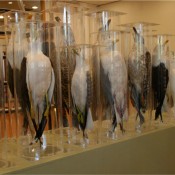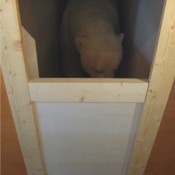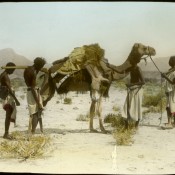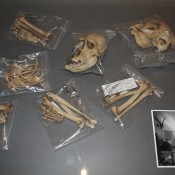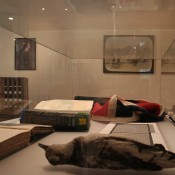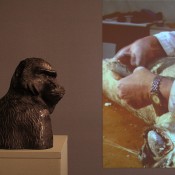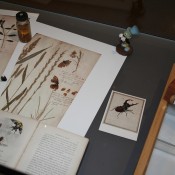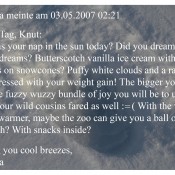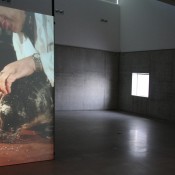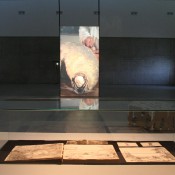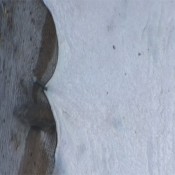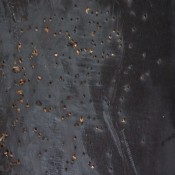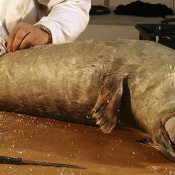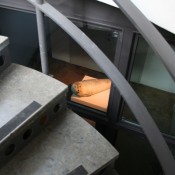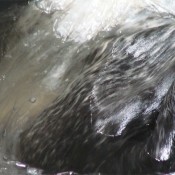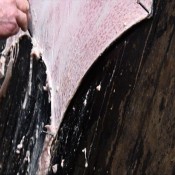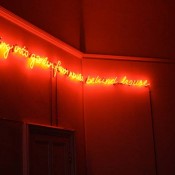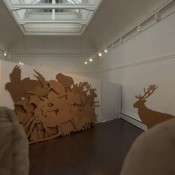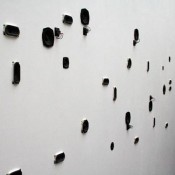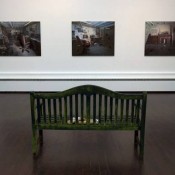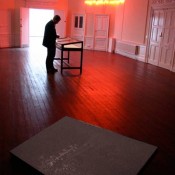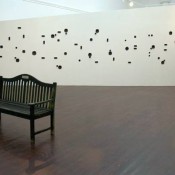Animal Matters
Galleri Sverdrup, Georg Sverdrups hus, Blindern, Oslo. 11 May to 24 August 2012
When Liv Emma Thorsen offered us the opportunity to work with a team of academics engaged in a research project exploring “what is an animal?” its possibilities seemed tantalizingly irresistable. Through our own work we were already familiar with a number of the participants and on familiarizing ourselves further with all the research specific to this project, the respective papers, and consequent conversation through correspondence, we found the content sitting surprisingly close to our own concerns and artwork. As artists whose practice engages with human/animal relations and what they reveal about ourselves and our relationship to the environment, the question of representation – who speaks for whom? – is paramount. To translate a thought into an object, (and here it is hoped, objects into thoughts) and for it to carry particular meanings, also raises questions that are topical in the context of academia and artistic research. In our own artwork, relationality is of particular importance and in our contribution to this project we acknowledge and it is hoped, expose a complex web of meaning accretion. Significant resonance is present for instance within the narrative microcosm of each exhibit. In turn, it exists between all the exhibits, between the objects, the gallery space and their institutional context here and between these components and the specific wordling of the visitor to this exhibition. Here, discrete histories well up refreshingly from ancient artefacts and are revealed as subjective, intimate. As such they remind us that knowledge is always subject to revision and history can tell us not only why we are what we are today, but how else we can be.Animal Matters is a project residing somewhere between curatorial practice and the practice of art, leading amongst other productions including a book, to an exhibition in The Svedrup Galleri at the University of Oslo. This exhibition involved a collaboration with nine academics and their research arising from a number of discrete fields across the humanities and sciences.
As artists whose research-based practice engages strategically with human-animal relations and what these can reveal about our behaviour and our relationship to the environment, the question of representation – who is speaking for whom – is crucial. To translate a thought into an object, for it to carry a particular meaning also carries with it questions that are topical in the context of academia and artistic research. In our artwork, relationality is of great importance. It’s in the connection between things – for instance the objects in the exhibition – the objects and the exhibition space – the objects and the context of the exhibition – between part or all of these components and/or the worlding of the visitor to this exhibition – that the meanings are generated and take shape. In those moments of encounter, a shift in thinking is made possible. In that shift – in that destabilising, a door opens and beyond it, lies the possibility of new knowledge and of behavioural change
It is in the unreliability of objects that we find the significance of any display productively unstable, in flux and capable of offering not one but a multitude of narratives – by the removal of this or the addition of that – never individually to be trusted as conclusive. In this project therefore, it was in this precarious dynamic and the potentialities of an array of juxtaposed narratives, arcing between each other, that the fascination and the challenge lay.
So with this in mind there were many factors to consider in respect of the work of each of the nine researchers involved, Brian Ogilvie, Karen Rader, Siv Berg, Guro Flinterud, Nigel Rothfels, Brita Brenna , Adam Dodd, Liv Emma Thorsen, Henry McGhie.
Initially for us as artists, the task also raised questions relating to ownership and autonomy. In some senses we were approaching the project not only as artists but as curators – of material yes, but also of ideas. We say initially because these questions were soon put aside and we did rather plunge in with a degree of confidence concerning what would most certainly evolve. We mentioned already the issue of relationality, as being of high importance during the process of development in our artwork and indeed in our installation work. To evoke this relationality through disparate objects and to prime the potential conversation between a variety of assemblages requires an understanding also of spatial relations and how these relations might be usefully activated.
Our artwork critiques the flawed application of representations (and animal representations in particular) – conveniences we have become accustomed to digesting without thinking. We take these representations as they appear within the context of art, popular culture and historical collections and by a process of often seemingly slight adjustment or careful juxtaposition, we shift a balance within pre-coded framings of the ‘image’. It is within the second, longer look by the viewer, this prompt to think again and in the resultant space of unexpected affect (humour, dissonance, surprise) that the art functions.
between you and me
between you and me (2009) acknowledges the presence of non-human-animals as co-partners in any human-animal dialogue with landscape. It set out to test the effects of representation and the consequent depletion of the referent. We wished to investigate the relationships between naming and taming, the functionality and consequences of animal image appropriation and depletion and to voice ideas concerning the perception of ‘environment’ and ‘wilderness’ in relation to both human and non-human occupancy and usage. We were also keen to consider environmental ontology in the context of historically incremental detachment from ‘wild’ landscape and to test new interspecific relationality predicated on respect and inquisitiveness.
In the light of this, the project focused on the seal, a non-human-animal, widely appropriated in Western culture, for a variety of human-animal representations. In this specific it was our ambition to explore the logical indeterminacy of the seal within this cultural context and to use this complexity and variance in perception, usage and instrumentalisation as a way of extrapolation more widely in respect of human/non-human animal relations.
Featuring key works the naming of things and Three Attempts, the exhibition centred on the representations and intrinsic value of things and calls into question the myriad bases upon which we construct such representations. At each venue these two video works were installed alongside video interviews with Icelanders for whom the seal has been a significant animal, either in continuation of a cultural legacy through hunting or ‘farming’ or in relation more recently to their role as a tourist attraction.
Wilderness is a human concept defining amongst other things a world ‘beyond’ our control or even ‘understanding’. It is the bracketing of a physical space in the larger context of a belief in human supremacy. Our lack of engagement with environment is demonstrated by our dependence on being insulated from it.
In home, the artists challenged this statement directly, placing themselves at the ‘mercy’ of the elements whilst undertaking an ten-day walking expedition through the remote and pathless landscapes of the north of Iceland. In consistently misty conditions they had to rely on a mix of basic technology (a 1:100,000 scale map) and increasingly their own instincts to guide them through this rugged terrain. In such an environment, ‘home comforts’ are, indeed, relative – and clearly the most reassuring ‘things’ seen each day were the man-made cairns that continued to guide them ‘home’, and which are the focus of the exquisite photographs in home *.
*Mike Collier in exhibition catalogue Walk On 2013
Exhibition: Slúnkaríki, Ísafjörður, Iceland (1999)
BIG MOUTH interviews
Promised Land took as its starting point the idea of our reliance on fixed and hackneyed symbols and their relationship to the world they are intended to represent. The installation in the Centre for Contemporary Art in Tbilisi combined sculptural, video and printed elements within a single room and by juxtaposing selected symbols and other non-symbolic material elements, the work set out to destabilise their appararent reliability inviting instead, readings of transient and shifting hybridity. A series of wall-mounted prints depicted assemblages of transluscent symbolic forms interspersed with silhouetted found objects. A group of art students from one of the art schools in the City was enlisted to assist in locating local discarded materials, cardboard and furniture in the preparation of the central, sculptural component of the installation. Two video works explored the idea in relation to human expressions of discomfort in respect of unwanted interspecific intruders onto domestic premises and included a text work which, over a period of around 10 minutes by the gradual overlaying of multiple short phrases transformed the screen from black to (almost) white.
Promised Land questions the constitution of the interspecific outsider or ‘other’ within a dominant culture and the bases of acceptance or intolerance. The project considers how ecologies are identified or simply go unnoticed within cultures fixated on individual phenomena and their supposed fixed identity. It considers how the association or juxtaposition of material bodies form new and changing phenomena and meaning, irrespective of human agency or perspective. The project examines the concept of human fear and discomfort in the context of the familiar and how these conditions are manifest in unpredictable and disparate ways. As much as anything, through the deployment of an interspecific lens, the work tests how routine and familiarity, central to our subconscious may be disrupted and threatened sometimes overwhelmingly by marginal and persistent disruption, both actual and imagined.
exhibition: Centre for Contemporary Art, Tbilisi, Georgia
